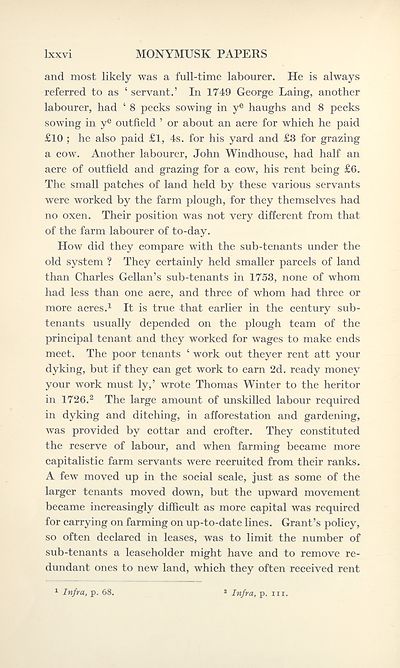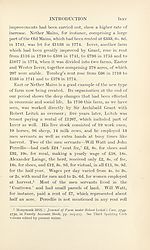Series 3 > Selections from the Monymusk Papers, 1713-1775
(81) Page lxxvi
Download files
Complete book:
Individual page:
Thumbnail gallery: Grid view | List view

Ixxvi
MONYMUSK PAPERS
and most likely was a full-time labourer. He is always
referred to as ‘ servant.’ In 1749 George Laing, another
labourer, had ‘ 8 pecks sowing in ye haughs and 8 pecks
sowing in ye outfield ’ or about an acre for which he paid
£10 ; he also paid £l, 4s. for his yard and £3 for grazing
a cow. Another labourer, John Windhouse, had half an
acre of outfield and grazing for a cow, his rent being £6.
The small patches of land held by these various servants
were worked by the farm plough, for they themselves had
no oxen. Their position was not very different from that
of the farm labourer of to-day.
How did they compare with the sub-tenants under the
old system ? They certainly held smaller parcels of land
than Charles Gellan’s sub-tenants in 1753, none of whom
had less than one acre, and three of whom had three or
more acres.1 It is true that earlier in the century sub¬
tenants usually depended on the plough team of the
principal tenant and they worked for wages to make ends
meet. The poor tenants ‘ work out theyer rent att your
dyking, but if they can get work to earn 2d. ready money
your work must ly,’ wrote Thomas Winter to the heritor
in 1726.2 The large amount of unskilled labour required
in dyking and ditching, in afforestation and gardening,
was provided by cottar and crofter. They constituted
the reserve of labour, and when farming became more
capitalistic farm servants were recruited from their ranks.
A few moved up in the social scale, just as some of the
larger tenants moved down, but the upward movement
became increasingly difficult as more capital was required
for carrying on farming on up-to-date lines. Grant’s policy,
so often declared in leases, was to limit the number of
sub-tenants a leaseholder might have and to remove re¬
dundant ones to new land, which they often received rent
Infra, p. 68.
2 Infra, p.
MONYMUSK PAPERS
and most likely was a full-time labourer. He is always
referred to as ‘ servant.’ In 1749 George Laing, another
labourer, had ‘ 8 pecks sowing in ye haughs and 8 pecks
sowing in ye outfield ’ or about an acre for which he paid
£10 ; he also paid £l, 4s. for his yard and £3 for grazing
a cow. Another labourer, John Windhouse, had half an
acre of outfield and grazing for a cow, his rent being £6.
The small patches of land held by these various servants
were worked by the farm plough, for they themselves had
no oxen. Their position was not very different from that
of the farm labourer of to-day.
How did they compare with the sub-tenants under the
old system ? They certainly held smaller parcels of land
than Charles Gellan’s sub-tenants in 1753, none of whom
had less than one acre, and three of whom had three or
more acres.1 It is true that earlier in the century sub¬
tenants usually depended on the plough team of the
principal tenant and they worked for wages to make ends
meet. The poor tenants ‘ work out theyer rent att your
dyking, but if they can get work to earn 2d. ready money
your work must ly,’ wrote Thomas Winter to the heritor
in 1726.2 The large amount of unskilled labour required
in dyking and ditching, in afforestation and gardening,
was provided by cottar and crofter. They constituted
the reserve of labour, and when farming became more
capitalistic farm servants were recruited from their ranks.
A few moved up in the social scale, just as some of the
larger tenants moved down, but the upward movement
became increasingly difficult as more capital was required
for carrying on farming on up-to-date lines. Grant’s policy,
so often declared in leases, was to limit the number of
sub-tenants a leaseholder might have and to remove re¬
dundant ones to new land, which they often received rent
Infra, p. 68.
2 Infra, p.
Set display mode to:
![]() Universal Viewer |
Universal Viewer | ![]() Mirador |
Large image | Transcription
Mirador |
Large image | Transcription
Images and transcriptions on this page, including medium image downloads, may be used under the Creative Commons Attribution 4.0 International Licence unless otherwise stated. ![]()
| Scottish History Society volumes > Series 3 > Selections from the Monymusk Papers, 1713-1775 > (81) Page lxxvi |
|---|
| Permanent URL | https://digital.nls.uk/127719981 |
|---|
| Attribution and copyright: |
|
|---|
| Description | Over 180 volumes, published by the Scottish History Society, containing original sources on Scotland's history and people. With a wide range of subjects, the books collectively cover all periods from the 12th to 20th centuries, and reflect changing trends in Scottish history. Sources are accompanied by scholarly interpretation, references and bibliographies. Volumes are usually published annually, and more digitised volumes will be added as they become available. |
|---|


